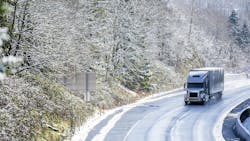Beyond maintenance: How fleets can prepare for safe winter operations
When it comes to winter preparation, the trucking industry is all too familiar with the best maintenance practices. FleetOwner contributors have spent the past month sharing subject matter expertise on wintertime operations. But let’s now take a different approach to the winter conversation: fleet safety.
Snow and ice threaten the safety of truck drivers, their equipment, their cargo, and the motoring public. However, proper preparation, technology, and communication can help mitigate winter risks.
How to prep for safe winter driving
There are multiple things truck drivers can do to promote their own safety before even setting out on the road. Here are a few tips from CloudTrucks on how to prepare this winter:
- Keep an emergency kit: A driver’s emergency kit should include snow chains, open flames, electric lanterns and/or flashlights, heavy clothing, backup sleeping bag/blankets, extra road flares, non-perishable food items, extra water, radio, backup cell phone battery banks/chargers, extra washer fluid, etc.
- Clean ice and snow off mirrors, windows, lights, and windshield wipers before driving: To ensure visibility, drivers should clear off their mirrors, windows, lights, and wipers before driving and as needed while driving.
- Practice chaining ahead of time: This tip is especially important whether you’re a trucking newbie or a seasoned pro needing practice.
In addition to truck drivers being prepared, fleet managers can also make strides to prepare their drivers.
- Emphasize the importance of pre- and post-trip inspections: While this article won’t focus on maintenance, one step fleet managers can take this winter is to ensure pre- and post-trip inspections are prioritized and conducted properly.
- Maintain a safety culture: When a fleet has a safety culture, drivers know to prioritize their own safety. Fleet managers can emphasize to their drivers the importance of safety over efficiency and empower them to trust their own instincts.
- Promote preparedness: Before winter hits, fleet managers can ensure their drivers are prepared and have all the tools and supplies needed for possible inclement weather. Winter training could also be useful to drivers, especially those newer in their careers.
See also: Fontana: Winter maintenance tips and best practices
How technology can boost safe winter driving
For fleets wanting to improve their winter safety, there are multiple technology options that could help. Trimble Transportation recommends the following tech:
- Telematics with weather alerts: Telematics solutions that alert drivers to changing weather patterns and road conditions can help keep drivers informed during the winter months.
- Remote diagnostics: Winter weather and temperatures can be hard on all vehicles. Remote diagnostic solutions can help fleets better understand what is going on with their vehicles and how it may or may not relate to winter weather.
- Dash cams, mirror cabs, in-cab video, etc.: Accidents are not always preventable, but fleet technology dash cameras can help capture what happens when a truck is in an accident and can help exonerate a driver in some situations.
How fleet communication is essential to safe winter driving
While poor winter conditions aren’t always avoidable, fleets can avoid poor communication. The following winter communication tips come from FleetOwner’s expert contributors:
- Stay informed: According to Steve Vaughn, senior vice president of field operations at PrePass Safety Alliance, in a blog from earlier this week, it’s important for dispatchers to stay up to date on weather conditions via radio stations and DOT websites so they can keep drivers informed and update routes as needed.
- Communicate expectations: Drivers shouldn’t have to guess at their fleet’s winter policies. Like Jane Clark, SVP of operations for NationaLease, outlines in her recent winter guide, make any maintenance, safety, and emergency policies clear to drivers before necessary.
- Plan ahead: The emphasis in this article is on preparedness. According to Gino Fontana, COO and EVP at Transervice Logistics Inc., in a blog from last month, it isn’t sufficient to wait for a weather event to appear to start planning for it. Plan and communicate about winter emergency procedures before your drivers are stuck in a storm.
About the Author

Jenna Hume
Digital Editor
Digital Editor Jenna Hume joined FleetOwner in November of 2023 and previously worked as a writer in the gaming industry. She has a bachelor of fine arts degree in creative writing from Truman State University and a master of fine arts degree in writing from Lindenwood University. She is currently based in Missouri.
